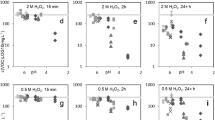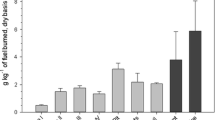Abstract
Perfluorinated compounds, including fluorotelomers, are important constituents of firefighting foams to extinguish fuel fires in the petrochemical industry, airports, and at fire-training sites. In this study, we monitored the biodegradation process in a co-contamination scenario with monoaromatic hydrocarbons commonly found in fuels (benzene, toluene) and fluorotelomers. The CO2 production rates were evaluated by a factorial design taking into account the effect of seasonality at in situ natural attenuation processes. Headspace analysis by gas chromatography with a thermal conductivity detector (GC-TCD) was applied to detect CO2 production, whereas monoaromatics were analyzed by gas chromatography coupled to mass spectrometry (GC–MS). According to our results, seasonality had a detectable effect during summer, yielding different CO2 production rates. Higher temperatures increased CO2 production rate, while higher concentrations of fluorotelomer inhibited the biodegradation process. On average, benzene and toluene were depleted 17.5 days earlier in control assays without fluorotelomers. Toluene removal efficiency was also notably higher than benzene. The noticeable decrease in degradation rates of monoaromatics was caused by perfluorinated compounds that are possibly linked to metabolic inhibition mechanisms. Fluorotelomer diminished catabolism in all of our batch cultures. In addition to this, an alternative production of by-products could be detected. Thus, we propose that transient components of the benzene and toluene degradation may be differentially formed, causing the benzene, toluene, and perfluorinated co-contaminations to go through switched metabolic stages under the presence of fluoride in a contamination scenario.




Similar content being viewed by others
References
Alexander M (1975) Environmental and microbiological problems arising from recalcitrant molecules. Microb Ecol 2:17–27
Aparício JD, Raimondo EE, Gil RA, Benimeli CS, Polti MA (2018) Actinobacteria consortium as an efficient biotechnological tool for mixed polluted soil reclamation: experimental factorial design for bioremediation process optimization. J Hazard Mater 342:408–417
Bielefeldt AR, Stensel HD (1999) Evaluation of biodegradation kinetic testing methods and longterm variability in biokinetics for BTEX metabolism. Water Res 33:733–740
Borg A, Njå O (2013) The concept of validation in performance-based fire safety engineering. Saf Sci 52:57–64
Chettouh S, Hamzi R, Benaroua K (2016) Examination of fire and related accidents in Skikda Oil Refinery for the period 2002–2013. J Loss Prevent Proc 41:186–193
Choi H, Lee J (2011) Groundwater contamination and natural attenuation capacity at a petroleum spilled facility in Korea. J Environ Sci 23:1650–1659
Cholakov GS (2016) Air quality and the petroleum industry. In: de la Guardia M, Armenta S (eds) Comprehensive analytical chemistry, 73rd edn. Elsevier, New York, pp 563–587
Dauchy X, Boiteux V, Bach C, Rosin C, Munoz J (2017) Per- and polyfluoroalkyl substances in firefighting foam concentrates and water samples collected near sites impacted by the use of these foams. Chemosphere 183:53–61
Donaldson D (2016) New foam improves firefighting capabilities. Mater Today 19:63
El-Naas MH, Acio JA, Telib AE (2014) Aerobic biodegradation of BTEX: progresses and prospects. J Environ Chem Eng 2:1104–1122
Fernández EL, Merlo EM, Mayor LR, Camacho JV (2016) Kinetic modelling of a diesel-polluted clayey soil bioremediation process. Sci Total Environ 557:276–284
Figueredo RCR, Sabadini E (2003) Firefighting foam stability: the effect of the drag reducer poly(ethylene) oxide. Colloids Surf A Physicochem Eng Asp 215:77–86
Freije AM (2015) Heavy metal, trace element and petroleum hydrocarbon pollution in the Arabian Gulf: review. Journal of the Association of Arab Universities for Basic and Applied Sciences 17:90–100
Ghattas A, Fischer F, Wick A, Ternes TA (2017) Anaerobic biodegradation of (emerging) organic contaminants in the aquatic environment. Water Res 116:268–295
Gieg LM, Fowler SJ, Berdugo-Clavijo C (2014) Syntrophic biodegradation of hydrocarbon contaminants. Curr Opin Biotechnol 27:21–29
Gołębiowski M, Siedlecka E, Paszkiewicz M, Brzozowski K, Stepnowski P (2011) Perfluorocarboxylic acids in cell growth media and technologically treated waters: determination with GC and GC–MS. J Pharm Biomed Anal 54:577–581
Hamed TA, Bayraktar E, Mehmeto T, Mehmeto U (2003) Substrate interactions during the biodegradation of benzene, toluene and phenol mixtures. Process Biochem 39:27–35
Hinnant KM, Giles SL, Ananth R (2017) Measuring fuel transport through fluorocarbon and fluorine-free firefighting foams. Fire Saf J 91:653–661
Jonsson P, Gullerg J, Nordstrom A, Kusano M, Kowalczylk M, Sjostrom M, Moritz T (2004) A strategy for identifying differences in large series of metabolomic samples analyzed by GC/MS. Anal Chem 76:1738–1745
Kadri T, Rouissi T, Brar SK, Cledon M, Sarma S, Verma M (2017) Biodegradation of polycyclic aromatic hydrocarbons (PAHs) by fungal enzymes: a review. J Environ Sci 51:52–74
Kapellos GE (2017) Microbial strategies for oil biodegradation. In: Becker SM (ed) Modeling of microscale transport in biological processes. Academic Press, New York, pp 19–39
Khatoon N, Jamal A, Ali MI (2017) Polymeric pollutant biodegradation through microbial oxidoreductase: a better strategy to safe environment. Int J Biol Macromol 105:9–16
Khodaei K, Nassery HR, Asadi MM, Mohammadzadeh H, Mahmoodlu MG (2017) BTEX biodegradation in contaminated groundwater using a novel strain (Pseudomonas sp. BTEX-30). International Biodeterioration & Biodegradation 116:234–242
Kim SJ, Kweon O, Cerniglia CE (2009) Proteomic applications to elucidate bacterial aromatic hydrocarbon metabolic pathways. Curr Opin Microbiol 12:301–309
Kolvenbach BA, Helbling DE, Kohler HE, Corvini PF (2014) Emerging chemicals and the evolution of biodegradation capacities and pathways in bacteria. Curr Opin Biotechnol 27:8–14
Laitinen JA, Koponen J, Koikkalainen J, Kiviranta H (2014) Firefighters’ exposure to perfluoroalkyl acids and 2-butoxyethanol present in firefighting foams. Toxicol Lett 231:227–232
Littlejohns JV, Daugulis AJ (2008) Kinetics and interactions of BTEX compounds during degradation by a bacterial consortium. Process Biochem 43:1068–1076
Martínková L, Uhnáková B, Pátek M, Nešvera J, Kren V (2009) Biodegradation potential of the genus. Environ Int 35:162–177
Mathur AK, Majumder CB (2010) Kinetics modelling of the biodegradation of benzene, toluene and phenol as single substrate and mixed substrate by using Pseudomonas putida. Chem Biochem Eng Q 24:101–109
McGenity TJ (2014) Hydrocarbon biodegradation in intertidal wetland sediments. Curr Opin Biotechnol 27:46–54
Meckenstock RU, Safinowski M, Griebler C (2004) Anaerobic degradation of polycyclic aromatic hydrocarbons. FEMS Microbiol Ecol 49:27–36
Meyer DD, Beker SA, Bücker F, Peralba MCR, Frazzon APG, Osti JF, Andreazza R, Camargo FAP, Bento FM (2014) Bioremediation strategies for diesel and biodiesel in oxisol from southern Brazil. Int Biodeterior Biodegradation 95:356–363
Mishra N, Ayoko GA, Morawska L (2016) Atmospheric polycyclic aromatic hydrocarbons in the urban environment: occurrence, toxicity and source apportionment. Environ Pollut 208:110–117
Monero A, Lanza L, Zilli M, Sene L, Converti A (2003) Batch kinetics of Pseudomonas sp. growth on benzene. Modeling of product and substrate inhibitions. Biotechnol Prog 19:676–679
Montagnolli RN, Lopes PRM, Bidoia ED (2014) Screening the toxicity and biodegradability of petroleum hydrocarbons by a rapid colorimetric method. Arch Environ Contam Toxicol 12:1–12
Montagnolli RN, Lopes PRM, Cruz JM, Claro MT, Quiterio GM, Bidoia ED (2017) Metabolical shifts towards alternative BTEX biodegradation intermediates induced by perfluorinated compounds in firefighting foams. Chemosphere 173:49–60
Nadim F, Hoag GE, Liu S, Carley RJ, Zack P (1999) Detection and remediation of soil and aquifer systems contaminated with petroleum products: an overview. J Pet Sci Eng 26:169–178
NFPA - National Fire Protection Association (1991) Fire protection handbook, 17th edn. NFPA, Quincy
Nolan DP (2011) Historical survey of fire and explosions in the hydrocarbon industries. In: Nolan DP (ed) Handbook of fire and explosion protection engineering principles, 2nd edn. William Andrew Publishing, Oxford, pp 71–82
Oberoi AS, Philip L (2017) Variation in toxicity during the biodegradation of various heterocyclic and homocyclic aromatic hydrocarbons in single and multi-substrate systems. Ecotoxicol Environ Saf 135:337–346
Panneerselvan P, Sivaram AK, Mallavarapu M, Naidu R (2016) Evaluation of cyto- and genotoxic effects of Class B firefighting foam products: Tridol-S 3% AFFF and Tridol-S 6% AFFF to Allium cepa. Environmental Technology & Innovation 6:185–194
Postigo C, Martinez DE, Grondona S, Miglioranza KSB (2017) Groundwater pollution: sources, mechanisms, and prevention. In: Elias SA (ed) Reference module in earth systems and environmental sciences. Elsevier, New York, pp 143–162
Qin XS, Huang GH, He L (2009) Simulation and optimization technologies for petroleum waste management and remediation process control. J Environ Manag 90:54–76
Rajamanickam R, Kaliyamoorthi K, Ramachandran N, Baskaran D, Krishnan J (2017) Batch biodegradation of toluene by mixed microbial consortia and its kinetics. International Biodeterioration & Biodegradation 119:282–288
Ramos JL, Marques S, Timmis KN (1997) Transcriptional control of the Pseudomonas TOL plasmid catabolic operons is achieved through an interplay of host factors and plasmid-encoded regulators. Annu Rev Microbiol 51:341–372
Runefors M, Johansson N, van Hees P (2017) The effectiveness of specific fire prevention measures for different population groups. Fire Saf J 91:1044–1050
Singh D, Fulekar MH (2010) Benzene bioremediation using cow dung microflora in two phase partitioning bioreactor. J Hazard Mater 175:336–343
Su Y, Zhang X, Wei X, Kong J, Xia F, Li W, He R (2014) Evaluation of simultaneous biodegradation of methane and toluene in landfill covers. J Hazard Mater 274:367–375
Tobiszewski M, Namieśnik J (2012) PAH diagnostic ratios for the identification of pollution emission sources. Environ Pollut 162:110–119
Varjani SJ (2017) Microbial degradation of petroleum hydrocarbons. Bioresour Technol 223:277–286
Vecitis CD, Park H, Cheng J, Mader BT, Hoffmann MR (2009) Treatment technologies for aqueous perfluorooctanesulfonate (PFOS) and perfluorooctanoate (PFOA). Front Environ Sci En 3:129–151
Vinuselvi P, Kim MK, Lee SK, Ghim CM (2012) Rewiring carbon catabolite repression for microbial cell factory. BMB Rep 45:59–70
Vogt C, Dorer C, Musat F, Richnow H (2016) Multi-element isotope fractionation concepts to characterize the biodegradation of hydrocarbons—from enzymes to the environment. Curr Opin Biotechnol 41:90–98
Wang S, Kuo Y, Hong A, Chang Y, Kao C (2016) Bioremediation of diesel and lubricant oil-contaminated soils using enhanced landfarming system. Chemosphere 164:558–567
Yang Y, Li J, Xi B, Wang Y, Tang J, Wang Y, Zhao C (2017) Modeling BTEX migration with soil vapor extraction remediation under low-temperature conditions. J Environ Manag 203:114–122
Yeom SH, Yoo YJ, Lee JW (1997) The importance of microbial adaptation in the degradation of BTX—studies in environmental science, 1st edn. Elsevier, New York
Zhang X, Mehaffey J, Hadjisophocleous G (2016) Life risks due to fire in mid- and high-rise, combustible and non-combustible residential buildings. J Build Eng 8:189–197
Zhao X, Wang L, Ma F, Bai S, Yang J, Qi S (2016) Pseudomonas sp. ZXY-1, a newly isolated and highly efficient atrazine-degrading bacterium, and optimization of biodegradation using response surface methodology. J Environ Sci 54:152–159
Zhuo S, Du W, Shen G, Wang R, Pan X, Li T, Han Y, Li Y, Pan B, Peng X, Cheng H, Wang X, Shi G, Xing B, Tao S (2017) Urban air pollution and health risks of parent and nitrated polycyclic aromatic hydrocarbons in two megacities, southwest China. Atmos Environ 166:441–453
Acknowledgements
Our research group acknowledges CAPES (Coordenação de Aperfeiçoamento de Pessoal de Nível Superior), CNPq (Conselho Nacional de Desenvolvimento Científico e Tecnológico), FUNDUNESP (Fundação para o Desenvolvimento da UNESP), PRH-ANP/MCT (Programa de Formação de Recursos Humanos em Geologia do Petróleo e Ciências Ambientais Aplicadas ao Setor de Petróleo e Gás), and UNESP (Universidade Estadual Paulista “Julio de Mesquita Filho”) for the financial support.
Author information
Authors and Affiliations
Corresponding author
Additional information
Responsible editor: Robert Duran
Rights and permissions
About this article
Cite this article
Montagnolli, R.N., Lopes, P.R.M. & Bidoia, E.D. Fluorinated waste and firefighting activities: biodegradation of hydrocarbons from petrochemical refinery soil co-contaminated with halogenated foams. Environ Sci Pollut Res 25, 36002–36013 (2018). https://doi.org/10.1007/s11356-018-1593-2
Received:
Accepted:
Published:
Issue Date:
DOI: https://doi.org/10.1007/s11356-018-1593-2




